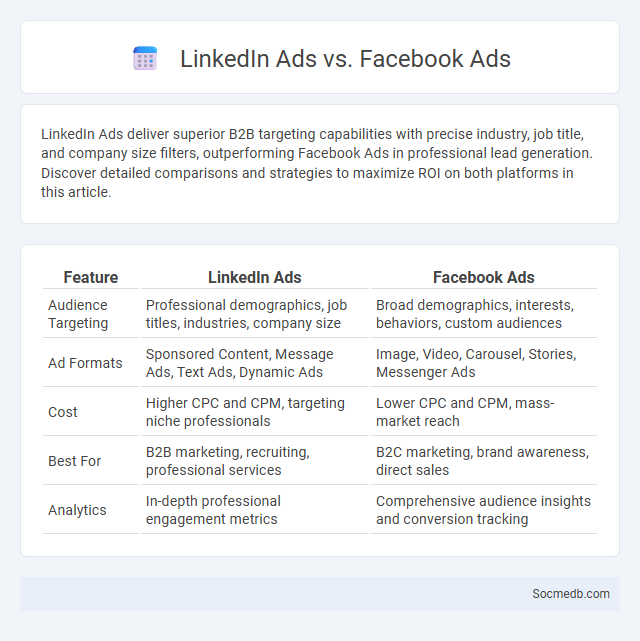
Photo illustration: LinkedIn Ads vs Facebook Ads
LinkedIn Ads deliver superior B2B targeting capabilities with precise industry, job title, and company size filters, outperforming Facebook Ads in professional lead generation. Discover detailed comparisons and strategies to maximize ROI on both platforms in this article.
Table of Comparison
| Feature | LinkedIn Ads | Facebook Ads |
|---|---|---|
| Audience Targeting | Professional demographics, job titles, industries, company size | Broad demographics, interests, behaviors, custom audiences |
| Ad Formats | Sponsored Content, Message Ads, Text Ads, Dynamic Ads | Image, Video, Carousel, Stories, Messenger Ads |
| Cost | Higher CPC and CPM, targeting niche professionals | Lower CPC and CPM, mass-market reach |
| Best For | B2B marketing, recruiting, professional services | B2C marketing, brand awareness, direct sales |
| Analytics | In-depth professional engagement metrics | Comprehensive audience insights and conversion tracking |
Introduction to LinkedIn Ads, Facebook Ads, and Employer Branding
LinkedIn Ads leverage professional targeting options to reach decision-makers and industry experts, optimizing B2B marketing campaigns with precise audience segmentation. Facebook Ads offer extensive customization through demographic, interest, and behavior targeting, enabling brands to engage diverse consumer groups effectively on a global scale. Employer branding utilizes social media platforms to showcase company culture and values, attracting top talent by enhancing corporate reputation and employee advocacy.
Target Audience: Who Are You Reaching?
Understanding your target audience on social media involves analyzing demographics such as age, gender, location, interests, and online behaviors to tailor content effectively. Platforms like Facebook, Instagram, TikTok, and LinkedIn attract distinct user groups, making channel selection crucial for reaching specific segments. Utilizing analytics tools and audience insights enhances engagement by aligning posts with the preferences and needs of your ideal customers.
Ad Objectives: Recruitment vs Brand Awareness
Social media advertising for recruitment targets potential job candidates through precise demographic and interest-based data, optimizing campaigns for applications and conversions. Brand awareness campaigns prioritize broad reach and engagement metrics, aiming to increase recognition and recall among larger, less defined audiences. Choosing between recruitment and brand awareness objectives depends on specific business goals, budget allocation, and the desired audience interaction level.
Cost and Budget Considerations
Social media marketing budgets vary widely depending on platform choice, target audience, and campaign objectives, with small businesses typically allocating 5-15% of their overall marketing budget to social media. Cost factors include content creation, ad spend, influencer partnerships, and analytics tools, which can significantly impact overall expenditure. Efficient budget allocation involves balancing paid promotions and organic strategies to maximize ROI while minimizing costs.
Platform Features and Tools Comparison
Top social media platforms offer distinct features and tools tailored to different user needs, such as Instagram's visual-centric interface emphasizing Stories, Reels, and shopping integrations versus Twitter's real-time news updates, trending hashtags, and tweet threads. Facebook provides a comprehensive suite including groups, events, Marketplace, and advanced ad targeting options, while LinkedIn focuses on professional networking with features like endorsements, job postings, and publishing articles. TikTok's algorithm-driven feed prioritizes short-form video content with user-friendly editing tools, enabling high engagement and viral potential compared to YouTube's longer video format and monetization options.
Content Strategies for Each Platform
Effective content strategies for social media vary by platform due to differing audience behaviors and formats. Instagram thrives on high-quality visuals and Stories that promote engagement, while Twitter requires concise, timely updates and trending hashtags to capture real-time conversations. LinkedIn benefits from professional, thought-leadership articles and industry insights that foster networking and credibility within business communities.
Measuring Success: Key Metrics to Track
Tracking key social media metrics such as engagement rate, reach, and conversion rate provides valuable insights into your campaign's effectiveness. Monitoring follower growth and click-through rates helps optimize content strategies to better connect with your target audience. Measuring these performance indicators ensures you can continuously refine your approach for maximum impact.
Employer Branding: Beyond Paid Advertising
Employer branding thrives on authentic storytelling and employee advocacy, leveraging social media platforms to showcase company culture beyond paid advertising. Engaging content such as employee testimonials, behind-the-scenes videos, and interactive Q&A sessions enhances credibility and attracts top talent organically. Leveraging LinkedIn, Instagram, and TikTok strategically amplifies the employer's voice, fostering a genuine connection with potential candidates.
Case Studies: Real-World Campaign Examples
Social media case studies reveal how brands boost engagement and conversions by tailoring content to platform-specific audiences, with Nike's #JustDoIt campaign generating millions of user interactions through motivational storytelling. You can analyze these real-world examples to identify strategies that drive viral reach and foster authentic community connections. Data from such campaigns highlight the importance of influencer partnerships, micro-targeting, and interactive content in maximizing ROI.
Choosing the Right Approach for Your Hiring Goals
Selecting the right social media platform is essential for aligning with your hiring goals, as LinkedIn excels in professional networking while Instagram and Facebook offer broader audience engagement. Tailoring your content to match the platform's user behavior enhances candidate attraction and brand visibility. Leveraging targeted ads and analytics on these platforms optimizes recruitment efforts by reaching qualified candidates more efficiently.
 socmedb.com
socmedb.com